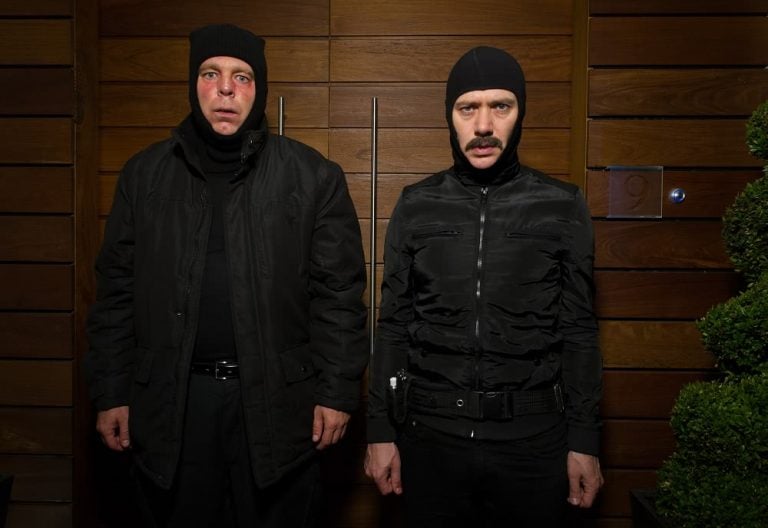The sheer surplus of shit to stream has no clearer casualty in Australia than Inside No. 9. In the U.K., the show is a cult hit, picking up well-deserved writing awards left and right, and even in the States it has a loyal, committed following. But over here, the program is largely unknown, thanks in no small part to Netflix’s decision to treat the best content they have like a dirty secret, pushing it deep within the folds of their site.
To which I say: fuck that. Inside No. 9 is, for my money, the best written television show of the last ten years, a stunning achievement that only gets stronger as the years pass. Created by Reece Shearsmith and Steve Pemberton – best known for their work as part of The League of Gentlemen, and the excellent dark comedy series Psychoville – Inside No. 9 is a horror-thriller-comedy anthology, with the episodes united only by a shared sense of vicious intelligence.
Watch an Inside No. 9 clip here:
Shearsmith and Pemberton are true horror aficionados – after all, The League Of Gentlemen, filled as it was with stranger-suspicious villagers, owed a clear debt to Robin Hardy’s cult classic The Wicker Man – and that love of genre shines throughout Inside No. 9. Season Two’s ‘The Trial Of Elizabeth Gadge’ is Witchfinder General shoved through a blender; ‘Seance Time’ is a deliciously creaky haunted house homage; while ‘The Devil Of Christmas’ stitches together touches from Struwwelpeter, the films of Dario Argento, and a heady dose of early Hammer Horror schlock.
But even those who consider themselves horror adverse will find they get a great deal from Inside No. 9. As dark as episodes can get, the sheer innovation of Shearsmith and Pemberton’s writing keeps proceedings entertaining – albeit in a distinctly grisly way. Episodes like ‘The Twelve Days Of Christine’, ‘Cold Comfort’, and ‘Sardines’ are stunningly compact, mini mysteries capped off by some of the most satisfying pay-offs in modern television history. While critics fawn over the lengthy, often tortured plots offered by more mainstream fare like The Leftovers and Westworld, Shearsmith and Pemberton are spinning 30 minute tales with more wit, intelligence, and life than those shows have in entire seasons.
Another unsung masterpiece lurking away from Netflix’s frontpage is Christine, the latest feature from Antonio Campos. Campos is probably best known to viewers as the filmmaker responsible for the first three episodes of the Jessica Biel-led mystery The Sinner – all those who choked on their tea when Biel’s Cora Tannetti stabbed a perfect stranger to death have him to thank (or, perhaps, to blame). But away from television, he is a brutally efficient director of tension, and Christine, based on the true story of doomed reporter Christine Chubbuck, is probably his masterpiece.
Chubbuck’s life story is defined by tragedy.
Chubbuck’s life story is defined by tragedy – those unaware of her shocking end would do best to avoid reading up on it before diving into Christine – but Campos’ film never feels exploitative, or tabloid-esque. Held together by a stunning performance by Rebecca Hall, who captures Chubbuck’s frazzled, anxious energy with real skill, the film has a deep sensitivity to it. Real, unaffected loss permeates through every scene, and by the time tragedy strikes, the viewer is so caught up in Chubbuck’s story that the loss of this 29-year-old woman feels as fresh as though it had happened only yesterday.
Watch the trailer for Christine here:
Over on Stan, fans of Sean Baker’s extraordinary The Florida Project would do well to check out Tangerine, his first feature. As with Florida, Tangerine showcases Baker’s skills as the poet of the underdog; shot entire on iPhones, the film has a gorgeous, tactile humanity to it. People have in the past compared Baker to Truffaut, but it’s an unfair comparison: Baker is as warm and unvarnished as Truffaut is composed and collected. For my money, Baker is the closest we have to a new Raymond Carver – an artist whose skill lies in translating tiny moments of regret, shame, pain, and beauty into shimmering moments of pure cinema.
For something completely different, I’d also strongly recommend, a trilogy of excellent world horror titles: High Tension, Raw, and Baskin, all playing on Stan. Those who decry the state of modern horror – sour-hearted old codgers who believe the genre has become nothing but a glut of overcranked snuff films – should shove these three masterpieces right in their goddamn maw and choke. The first, High Tension, the debut film from Alexandre Aja, is a deliciously slick nightmare, as unsettling and as cruel as The Texas Chainsaw Massacre. Sure, it falls apart when it comes time for the famously ludicrous ending, but every other minute of this nasty little film thrills.
Can Evrenol’s Baskin is a lit candle placed in front of the shrine of Lucio Fulci.
Raw, by contrast, wears its beating, bloodied heart on its sleeve. A coming-of-age story that also contains elements of cannibal drama, dark comedy, and woozy social satire, it is the most impressive horror debut since Sam Raimi’s The Evil Dead. Time will almost certainly reveal it to be one of the most effective and important films of the decade – who could say no to that finale, told with all the barely-suppressed glee of a dirty joke?
Then, finally, we have Can Evrenol’s Baskin, a lit candle placed in front of the shrine of Lucio Fulci. Beginning as a nightmarish cop procedural, the film takes a sudden and shocking tonal right turn about halfway through, transforming into something altogether meaner, weirder, and wetter. If there is any justice in the world, this debut future alone will guarantee Evrenol has the support and funding to make as many horror films as he bloody well wants.
For more film and TV content, read our review of the new film Upgrade here.


































